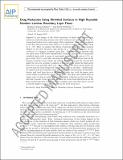Drag reduction using wrinkled surfaces in high Reynolds number laminar boundary layer flows
Author(s)
Raayai Ardakani, Shabnam; McKinley, Gareth H
Download2017-e.pdf (532.0Kb)
OPEN_ACCESS_POLICY
Open Access Policy
Creative Commons Attribution-Noncommercial-Share Alike
Terms of use
Metadata
Show full item recordAbstract
Inspired by the design of the ribbed structure of shark skin, passive drag reduction methods using stream-wise riblet surfaces have previously been developed and tested over a wide range of flow conditions. Such textures aligned in the flow direction have been shown to be able to reduce skin friction drag by 4%-8%. Here, we explore the effects of periodic sinusoidal riblet surfaces aligned in the flow direction (also known as a "wrinkled" texture) on the evolution of a laminar boundary layer flow. Using numerical analysis with the open source Computational Fluid Dynamics solver OpenFOAM, boundary layer flow over sinusoidal wrinkled plates with a range of wavelength to plate length ratios (λ/L), aspect ratios (2A/λ), and inlet velocities are examined. It is shown that in the laminar boundary layer regime, the riblets are able to retard the viscous flow inside the grooves creating a cushion of stagnant fluid that the high-speed fluid above can partially slide over, thus reducing the shear stress inside the grooves and the total integrated viscous drag force on the plate. Additionally, we explore how the boundary layer thickness, local average shear stress distribution, and total drag force on the wrinkled plate vary with the aspect ratio of the riblets as well as the length of the plate. We show that riblets with an aspect ratio of close to unity lead to the highest reduction in the total drag, and that because of the interplay between the local stress distribution on the plate and stream-wise evolution of the boundary layer the plate has to exceed a critical length to give a net decrease in the total drag force.
Date issued
2017-09Department
Massachusetts Institute of Technology. Department of Mechanical EngineeringJournal
Physics of Fluids
Publisher
American Institute of Physics (AIP)
Citation
Raayai-Ardakani, Shabnam and Gareth H. McKinley. “Drag Reduction Using Wrinkled Surfaces in High Reynolds Number Laminar Boundary Layer Flows.” Physics of Fluids 29, 9 (September 2017): 093605
Version: Author's final manuscript
ISSN
1070-6631
1089-7666